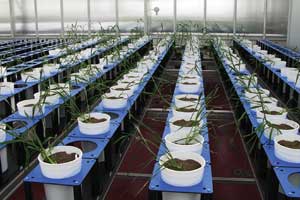Compiled by Photonics Spectra staff
To predict how plants will react to the
harsher environmental conditions expected under climate change, computer scientists
at the University of Adelaide have developed an image-based analysis method for
use by plant physiologists to determine crop yield.
They have joined plant physiologists and industry partner LemnaTec
to develop technology that will accurately estimate plant yield of potential new
cereal varieties well before grain production. In this method, a 3-D model of the
plant’s changing shape is generated based on images taken as it grows. This
model would then allow physiologists to quickly measure plant structural properties.

Plants growing in the Plant Accelerator at the Waite Campus. Courtesy of the University of Adelaide.
“We want to be able to predict yield based on a collection
of measurable plant attributes early in the plant’s life span, rather than
having to wait for the plant to mature and then measuring the yield,” said
professor Anton van den Hengel, director of the Australian Centre for Visual Technologies.
The image-based approach enables detailed, accurate and rapid
estimation of large numbers of plants’ potential yields under various growing
conditions, such as high salinity or drought. The technology could transform crop
breeding and the agricultural industry.
The new image-based analysis will be incorporated into the Plant
Accelerator at the university’s Waite Campus. Opened last year, it houses
more than 1 km of conveyor systems that deliver plants automatically to the imaging
and other stations.
The project, “Improving yield through image-based structural
analysis of cereals,” is funded by the Australian Research Council Linkage
Projects.
LemnaTec will help commercialize the technology.